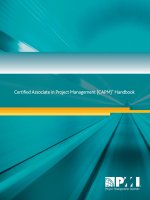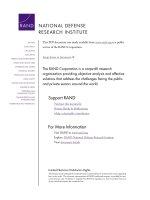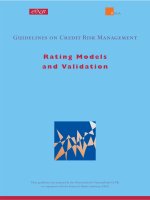ASSET VALUATION MODELS - CAPM & APT doc
Bạn đang xem bản rút gọn của tài liệu. Xem và tải ngay bản đầy đủ của tài liệu tại đây (230.14 KB, 10 trang )
CHAPTER FIVE: ASSET VALUATION
MODELS - CAPM & APT
06/08/2011 1
2
CAPM: Assumptions
• Investors are risk-averse individuals who maximize the
expected utility of their wealth
• Investors are price takers and they have homogeneous
expectations about asset returns that have a joint normal
distribution (thus market portfolio is efficient)
• There exists a risk-free asset such that investors may borrow or
lend unlimited amount at a risk-free rate.
• The quantities of assets are fixed. Also all assets are
marketable and perfectly divisible.
• Asset markets are frictionless. Information is costless and
simultaneously available to all investors.
• There are no market imperfections such as taxes, regulations,
or restriction on short selling.
06/08/2011
3
Derivation of CAPM
• If market portfolio exists, the prices of all assets must adjust until all are
held by investors. There is no excess demand.
• The equilibrium proportion of each asset in the market portfolio is
–
• A portfolio consists of a% invested in risky asset I and (1-a)% in the
market portfolio will have the following mean and standard deviation:
–
–
• A portfolio consists of a% invested in risky asset I and (1-a)% in the
market portfolio will have the following mean and standard deviation:
• Find expected value and standard deviation of with respect to the
percentage of the portfolio as follows.
)
~
()
~
(
)
~
(
mi
p
RERE
a
RE
assetsallofvaluemarket
assetindividualtheofvaluemarket
w
i
)
~
()1()
~
()
~
(
mip
REaRaERE
2/12222
])1(2)1([)
~
(
immip
aaaaR
p
R
06/08/2011
4
Derivation of CAPM
• Evaluating the two equations where a=0:
• The slope of the risk-return trade-off:
• Recall that the slope of the market line is:
;
• Equating the above two slopes:
]42222[])1(2)1([
2
1
)
~
(
2222/12222
imimmmiimmi
p
aaaaaaa
a
R
)
~
()
~
(
)
~
(
0 mia
p
RERE
a
RE
m
mim
immma
p
a
E
2
22/12
0
)22()(
2
1
)
~
(
mmim
mi
a
p
p
RERE
aR
aRE
/)(
)
~
()
~
(
/)
~
(
/)
~
(
2
0
m
fm
RRE
)
~
(
mmim
mi
m
fm
RERE
RRE
/)(
)
~
()
~
(
)
~
(
2
2
])
~
([)
~
(
m
im
fmfi
RRERRE
06/08/2011
5
Extensions of CAPM
1. No riskless assets
2. Forming a portfolio with a% in the market portfolio and (1-a)% in the
minimum-variance zero-beta portfolio.
3. The mean and standard deviation of the portfolio are:
–
–
4. The partial derivatives where a=1 are:
– ;
– ;
5. Taking the ratio of these partials and evaluating where a=1:
–
6. Further, this line must pass through the point and the intercept
is . The equation of the line must be:
–
)()1()()(
zmp
REaRaERE
2/12222
])1(2)1([)
~
(
mzzmzmp
raaaaR
m
zm
p
p
RERE
aR
aRE
)()(
/)(
/)(
)(),(
mm
RRE
)(
z
RE
p
m
zm
zp
RERE
RERE
]
)()(
[)()(
)()(
)(
zm
p
RERE
a
RE
]222[])1([
2
1
)(
2222/12222
zzmzm
p
aaaa
a
R
06/08/2011
6
Arbitrage Pricing Theory
• Assuming that the rate of return on any security is a linear function of k
factors:
Where Ri and E(Ri) are the random and expected rates on the ith asset
Bik = the sensitivity of the ith asset’s return to the kth factor
Fk=the mean zero kth factor common to the returns of all assets
εi=a random zero mean noise term for the ith asset
• We create arbitrage portfolios using the above assets.
•
• No wealth arbitrage portfolio
• Having no risk and earning no return on average
ikikiii
FbFbRER
)(
11
0
1
n
i
i
w
06/08/2011
Deriving APT
• Return of the arbitrage portfolio:
• To obtain a riskless arbitrage portfolio, one
needs to eliminate both diversifiable and
nondiversifiable risks. I.e.,
7
i
ii
i
kiki
i
ii
i
ii
n
i
iip
wFbwFbwREw
RwR
)(
11
1
i
ikii
factorsallforbwn
n
w 0,,
1
06/08/2011
Deriving APT
8
i
iip
REwR )(
0)(
i
ii
REw
How does E(Ri) look like? a linear combination
of the sensitivities
keachforbw
i
iki
0
As:
06/08/2011
9
APT
• There exists a set of k+1 coefficients, such that,
–
• If there is a riskless asset with a riskless rate of
return R
f
, then b
0k
=0 and R
f
=
–
• In equilibrium, all assets must fall on the arbitrage
pricing line.
0
ikkii
bbRE
)
~
(
110
ikkifi
bbRRE
)(
11
06/08/2011
APT vs. CAPM
• APT makes no assumption about empirical
distribution of asset returns
• No assumption of individual’s utility function
• More than 1 factor
• It is for any subset of securities
• No special role for the market portfolio in APT.
• Can be easily extended to a multiperiod framework.
10
06/08/2011









